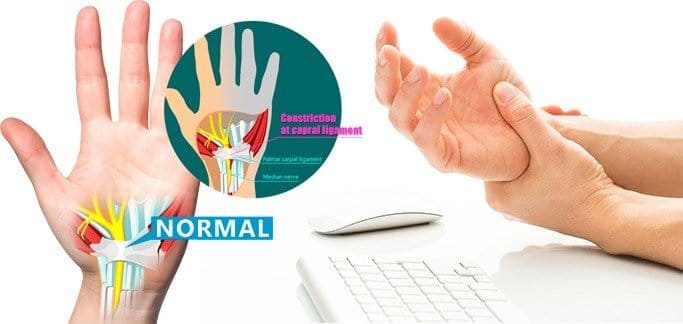
Carpal Tunnel Syndrome affects people of all shapes, sizes, and race causing pain in the arm, wrist, and hand. This pain is the result of a pinched nerve in the body’s carpal tunnel, a narrow gap through which nerves are funnelled into the hand. When this area becomes inflamed, the nerves become irritated causing pain, numbness, and tingling in the hand, wrist, arm, and fingers. Inflammation may be caused by repetitive motion, such as typing, inflammatory diseases such as arthritis, and even a poor diet causing mineral deficiencies.
There are a variety of treatment options for the Carpal Tunnel Syndrome. Anti-inflammatory medications such as NSAID’s and Corticosteroids may be prescribed in hopes of allowing the body to heal while the medicine keeps pain at bay. Some choose to use herbs like turmeric or helichrysum to help nerve pain. A physical therapist may suggest changes to work habits or daily chores affecting the wrists. In prolonged or severe cases, surgery may be recommended to enlarge the carpal tunnel and give nerves additional room. Along with each of these treatments, exercise is nearly always recommended. Exercises to alleviate symptoms of Carpal Tunnel Syndrome aren’t time-consuming, require no money, and have no recovery time.
Hulk Stretches
When the Hulk gets angry, he clenches his fists and turns green. In this case, the focus is on the clenched fists. Make a fist as hard as you can, and hold it for ten seconds, or as long as you are able. Then release your fingers and spread them as quickly and as far as you can. Keep stretching for another count of ten, then tighten your fingers back into a fist. Do ten repetitions of this exercise with each hand. This is a good one for when you need to relieve stress!
Make a fist, firm but not too tight. Position your arm so your knuckles point up. Slowly rotate your wrist until your fingers point up and knuckles are down. Stretch as far as you can without severe pain, and hold that position for ten seconds. Then rotate your wrist back to the original position slowly, and relax for ten seconds. Repeat ten times with each wrist.
Again making a firm fist, turn your wrist so that your thumb is facing upward. Extend your thumb at a ninety-degree angle from your hand, in the style of a hitchhiker. Stretching your thumb as far as you can without causing undue pain, rotate it in a clockwise motion. After ten repetitions, switch and rotate in a counter-clockwise motion ten times.
Like the kid in class who desperately wanted to answer the teacher’s question, for this exercise, you’ll stretch your arm above your head as far as you can. Next, stretch your wrist back towards your shoulder. Then flick your wrist forward and allow your entire arm to drop to your side. Ten repetitions are recommended for each side.
While this exercise is not based in any religious tradition, it might remind you of a yoga or meditation pose. Sitting up straight with your elbows out and arms approximately perpendicular to the ground, press your palms together. Align your fingers so that the middle finger of your right hand is aligned with the middle finger on your left, your right pinkie in full contact with the left, and so on. Turn your hands upwards, as in prayer. Pressing your fingers together, move your palms apart so that your four fingers are together from bottom knuckle to tip, your thumbs touch only at the tip, and your palms are not touching. Still pressing your fingers together, stretch your hand by separating each “set” of fingers, as if opening a Japanese folding fan. Then close your fingers slowly, and bring your palms back together. Again, try to do this ten times.
These exercises may help speed healing and restore your lifestyle. Do only as much as you are able, working your way up to the recommended number of repetitions if necessary. If an exercise causes pain, try scaling back the stretching or repetitions until you gain more strength.
Dr. Lev Kalika is a world-recognized expert in musculoskeletal medicine. with 20+ years of clinical experience in diagnostic musculoskeletal ultrasonography, rehabilitative sports medicine and conservative orthopedics. In addition to operating his clinical practice in Manhattan, he regularly publishes peer-reviewed research on ultrasound-guided therapies and procedures. He serves as a peer reviewer for Springer Nature.
Dr. Kalika is an esteemed member of multiple professional organizations, including: